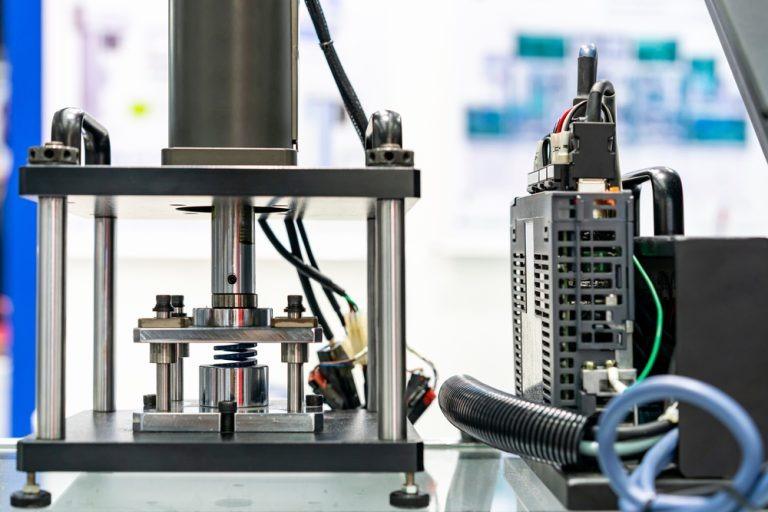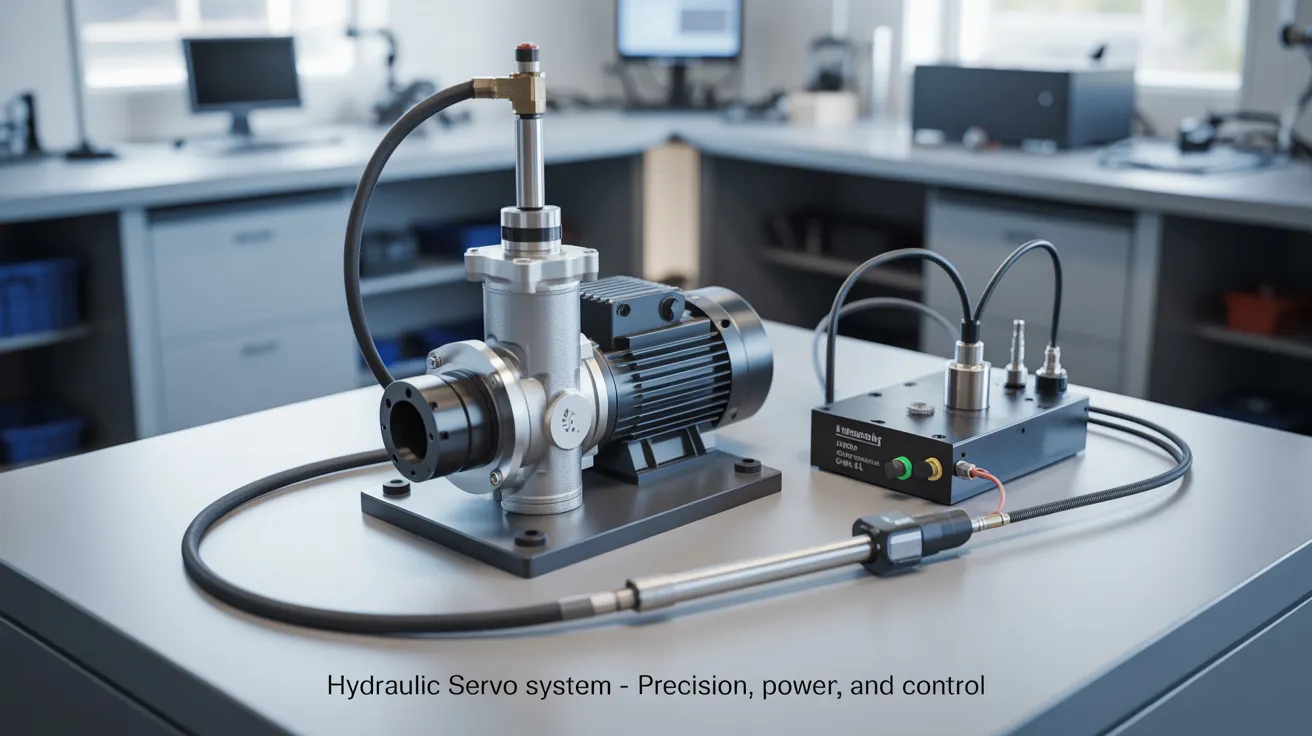Mastering Hydraulic Servo Control Systems: The Power of Precision Engineering

Picture yourself controlling a heavy excavator, an industrial press, or a robotic arm. Every motion needs to be precise, smooth, and perfectly timed. Behind that level of accuracy lies a hydraulic servo control system—a marvel of engineering that seamlessly blends mechanical power with electronic intelligence.

Whether it’s managing pressure, flow, or direction, servo systems have revolutionized how industries operate. From aerospace applications to modern manufacturing plants, the combination of hydraulic servo systems and load sensing proportioning valve adjustment delivers unmatched control and efficiency.
In this guide, you’ll dive deep into how these systems work, their advantages, the importance of proper calibration, and how leading hydraulic servo system suppliers like THM Huade are helping industries achieve new standards of precision and performance.
1. What Is a Hydraulic Servo Control System?
A hydraulic servo control system is a sophisticated mechanism that uses hydraulic power to perform controlled motion based on electrical input signals. Unlike conventional hydraulic systems that operate with fixed flow and pressure, servo-controlled systems dynamically adjust these parameters to match exact movement requirements.
This closed-loop system uses sensors and feedback mechanisms to continuously monitor and fine-tune performance, ensuring smooth, accurate, and responsive operation—even under varying loads.
Core Components Include:
-
Hydraulic Servo Valve: Regulates flow and pressure according to control signals.
-
Actuator or Hydraulic Cylinder: Converts fluid pressure into linear or rotary motion.
-
Feedback Sensors: Measure position, pressure, and speed to provide real-time data.
-
Electronic Controller: Processes input signals and adjusts the servo valve accordingly.
Essentially, it’s the brain of a hydraulic system—delivering electrical precision with hydraulic strength.
2. How Hydraulic Servo Systems Work
Imagine you want a robotic arm to lift a component to a specific height. When you input the command, the servo controller sends an electrical signal to the hydraulic servo valve, which adjusts fluid flow to the hydraulic cylinder.
A position sensor continuously monitors the cylinder’s movement and provides feedback to the controller. The system compares actual position data with the desired setpoint and makes micro-adjustments to achieve perfect motion control.
This closed-loop feedback system ensures:
-
Smooth acceleration and deceleration
-
Precise positioning and speed control
-
Reduced overshoot or oscillation
The result? Unmatched performance consistency in dynamic industrial environments.
3. Advantages of Hydraulic Servo Systems
Hydraulic servo systems have become indispensable in modern engineering due to their unique blend of power and precision.
Here’s why industries rely on them:
-
Exceptional Accuracy: Real-time feedback ensures pinpoint control.
-
High Power Density: Compact design with massive force output.
-
Fast Response: Instant reaction to control signals, even under load.
-
Energy Efficiency: Optimized fluid control reduces power loss.
-
Durability: Engineered for long-term reliability in harsh environments.
Whether in aerospace, robotics, marine systems, or industrial automation, hydraulic servo system outperform conventional hydraulics when precision is key.
4. Role of the Load Sensing Proportioning Valve
A vital part of hydraulic servo control systems is the load sensing proportioning valve (LSPV). This intelligent valve automatically adjusts hydraulic pressure based on load demand, ensuring balanced performance and energy efficiency.
When paired with a servo system, the load sensing proportioning valve adjustment becomes a game-changer. It allows for:
-
Smooth braking and acceleration control in mobile equipment.
-
Reduced energy waste by supplying only the pressure required.
-
Enhanced safety by maintaining consistent pressure distribution.
Regularly checking and fine-tuning valve adjustments ensures the servo system performs with precision, especially in machinery like cranes, loaders, and heavy vehicles.
Read More: The Role of Hydraulic Cylinder Pistons in Heavy Machinery Performance
5. The Synergy Between Servo Drives and Hydraulic Systems
In advanced setups, servo drive hydraulic pumps work alongside hydraulic servo control systems to create a perfect blend of electrical intelligence and hydraulic power.
Servo drives control motor speed and torque electronically, while hydraulic systems amplify that power through pressurized fluid. The combination results in a system that’s both powerful and efficient—ideal for applications that demand speed, accuracy, and load adaptability.
This integration is commonly found in automated manufacturing systems, metal forming machines, and mobile hydraulic applications where responsiveness and energy conservation are top priorities.
6. Why Proper Load Sensing Valve Adjustment Matters
Even the best-designed servo system can underperform without proper calibration of the load sensing proportioning valve.
When not adjusted correctly, it can lead to:
-
Pressure imbalances, reducing actuator precision.
-
Energy loss due to overcompensation in the system.
-
Overheating, which can degrade seals and hydraulic fluid.
Correct adjustment ensures:
-
Stable operation under variable loads.
-
Smooth, controlled motion transitions.
-
Optimized fuel or power consumption in mobile hydraulics.
Technicians typically perform valve adjustments during installation, maintenance, or after system overhauls to maintain consistent performance.
7. Hydraulic Servo Systems in Mobile Equipment
Mobile machinery like excavators, agricultural harvesters, and cranes rely heavily on servo control systems for safe and efficient operation.
Hydraulic servo systems control movements such as boom lifting, bucket rotation, and steering. The integration of load-sensing valves ensures that these machines adapt to changing loads and terrains, providing stability and accuracy even in rugged conditions.
When combined with modern electronics, these systems enable operators to achieve smoother control with minimal manual input—significantly improving productivity and safety.
8. Choosing the Right Hydraulic Servo System Supplier
Not all hydraulic servo systems are created equal. Selecting a reliable hydraulic servo system supplier is crucial for achieving optimal performance and long-term reliability.
When evaluating suppliers, consider these factors:
-
Technical Expertise: Proven experience in servo-hydraulic integration.
-
Customization Options: Ability to tailor systems for specific applications.
-
Component Quality: Use of durable valves, cylinders, and sensors.
-
Support and Maintenance: Availability of field service and spare parts.
Leading brands like THM Huade specialize in high-precision hydraulic servo systems designed for complex industrial and mobile applications. Their products combine intelligent design with dependable performance—offering unmatched control, reliability, and energy efficiency.
9. Common Challenges in Hydraulic Servo Systems
While powerful, servo-controlled hydraulics require precision in setup and maintenance. Some common challenges include:
-
Contamination: Dirt or debris can clog servo valves and affect responsiveness.
-
Seal Wear: Poor-quality seals can cause leaks and reduced pressure control.
-
Sensor Drift: Incorrect sensor feedback affects position accuracy.
-
Improper Calibration: Leads to system instability or energy inefficiency.
Routine inspection, fluid maintenance, and calibration checks are essential to avoid these pitfalls.
10. The Future of Hydraulic Servo Technology
As industries evolve, so do hydraulic systems. The next generation of servo hydraulics will integrate smart sensors, AI-based control algorithms, and IoT-enabled monitoring.
Imagine a system that can self-diagnose pressure loss, adjust its own load sensing proportioning valve, and alert operators before a failure occurs. This predictive maintenance capability will drastically reduce downtime and improve energy efficiency.
In addition, hybrid electro-hydraulic systems combining servo motors with electric hydraulic pumps are gaining popularity, delivering superior performance with lower energy consumption.
Read More: Why Radial Piston Pumps Are Perfect for Variable Flow Applications
11. Practical Maintenance Tips for Servo-Controlled Systems
To ensure your hydraulic servo control system performs reliably, keep these best practices in mind:
-
Regularly check hydraulic fluid levels and cleanliness.
-
Calibrate feedback sensors periodically.
-
Inspect valves and seals for signs of wear or leakage.
-
Ensure all electrical connections are secure.
-
Follow manufacturer-recommended maintenance schedules.
By doing so, you’ll extend the life of both the mechanical and electronic components, keeping your system operating at peak efficiency.
12. Why THM Huade Leads in Servo Hydraulic Innovation
As a global hydraulic servo system supplier, THM Huade has built a reputation for delivering cutting-edge hydraulic solutions engineered for precision, durability, and energy optimization.
Their servo control systems integrate seamlessly with proportional valves, actuators, and load-sensing components—making them ideal for modern mobile and industrial machinery. Each system is designed to balance power and control, ensuring consistent performance under dynamic conditions.
THM Huade’s commitment to research and innovation ensures their products stay ahead of evolving market demands, helping businesses achieve smarter, more efficient hydraulic operations.
Conclusion
The hydraulic servo control system represents the perfect marriage of power and intelligence. By combining advanced servo control with load sensing proportioning valve adjustment, industries can achieve superior accuracy, responsiveness, and energy efficiency.
Whether you’re managing an industrial press, a robotic assembly line, or mobile construction equipment, the precision of your hydraulic system depends on the quality of its design, calibration, and supplier.
As technology continues to advance, servo hydraulics will remain at the heart of modern engineering—where every movement counts, and every adjustment matters.
- Art
- Causes
- Crafts
- Dance
- Drinks
- Film
- Fitness
- Food
- Παιχνίδια
- Gardening
- Health
- Κεντρική Σελίδα
- Literature
- Music
- Networking
- άλλο
- Party
- Religion
- Shopping
- Sports
- Theater
- Wellness


